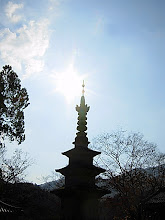 After the leaves have been picked they are transported to the production site, an open air facility that allows elements of nature to creep in and comfort the newly picked tea. Here the leaves are dumped from the large mesh bags onto a fibrous rush mat where they sit only for some time, awaiting their fate as tea. The leaves rest, a reprieve from what is to come.
After the leaves have been picked they are transported to the production site, an open air facility that allows elements of nature to creep in and comfort the newly picked tea. Here the leaves are dumped from the large mesh bags onto a fibrous rush mat where they sit only for some time, awaiting their fate as tea. The leaves rest, a reprieve from what is to come.At this time the twigs, old and torn leaves, and anything else that has made it into the basket and isn't top grade tea is picked out.

While the tea is left in calm, the cauldron is heated. Traditionally, the cauldrons were made of iron and fired by wood. Nowadays, they are made of Aluminum and are fired by gas. These changes were made out of modern convenience as it is extremely difficult to maintain a consistent temperature with the traditional wood burning type. It is very important that the temperature is stable and that the cauldrons are properly preheated between 250-350 degrees Celsius.

When the cauldron is ready, the leaves are thrust upon it. The dense pile of vegetation cries out in a hiss or cackle as the the moisture in the leaves connect with the hot heat of the aluminum. The result of this altercation is the smell of fresh tea that is carried by hot steam, released into the air, enveloping ones being. The smell is indescribably good, a smell that one will always remember, a smell that a blog can't give justice to.
The smell of the leaves are accompanied by brisk, tossing hand motions as the tea is careful stirred. It is important they are constantly being stirred as not to prevent burning. The technique used to hand stir the tea allows all of the leaves to be exposed to the heat for an equal amount of time so the flavour is evenly distributed throughout the leaves. As they are exposed to this initial step oxidization stops, the leaf is softened and the life energy of green tea is sealed within.

Cho Ui wrote the following about these steps,
After tea leaves are plucked, one must sort out old chipped leaves, and twigs. Put one and a half geun (approx 1 Kg) of tea leaves into a hot iron cauldron, about 2.5 feet in diameter and hand stir it. The cauldron must be extremely hot before tea leaves are placed into it. The leaves must be stirred quickly, but throughly and fully. One must not change the temperature of the cauldron while stirring the leaves...
It is virtually impossible to express the minute details of stirring tea leaves on a hot iron cauldron. When the heat is just right, the colour and aroma of tea leaves reach the ultimate level of beauty and the miracle of tea takes place, resulting in the mysteriously sublime taste of tea.
~
Paraphrased from a Translation of Cha Shin Jeon in The Book of Korean Tea by Yang-Seok Yoo with changes
Peace

5 comments:
Another two wonderful posts. I really like reading your insightful writing ofinto Korean tea. I'll be waiting for the next wonderful post.
Wes
Thanks for your kind words and intrest.
One must say that they have been enjoying your reviews as well.
Peace
Those tea leaves look amazing. Its nice learning more about Korean tea, thanks.
Thank you Matt for the beautiful pictures about tea and teaware. Korea is obscure in relation to other major tea-producing countries. However, that may not be true for long as I hope more individuals discover,drink and experience korean green tea (녹차),camellia sinensis. I was pleasantly surprised by them. Yes,they can be expensive, but depending on the tea farm,location,time of plucking, method of harvest, etc.are worth it. However,like other artisan teas, when fresh, can be intensely fragrant,subtle yet complex,and delicious. I have drank organic small-lot artisan Korean whole leaf green tea and Korean wild tea from Jirisan/Hwagae valley.I have found them to be incredibly fragrant,delicious,and unique.
Gabriel,
Those small lot Korean teas from Jiri Mountain/Hwagae Valley are sure a treat!
If you take into consideration that the whole process is done by hand- from picking to packing, that Korea is no longer a 'developing country', and wages for labour are always fair, then the price of Korean tea no longer seems that outrageous.
Peace
Post a Comment